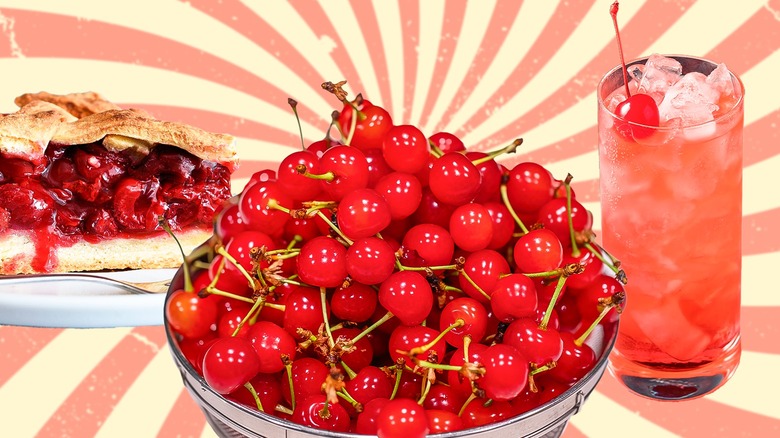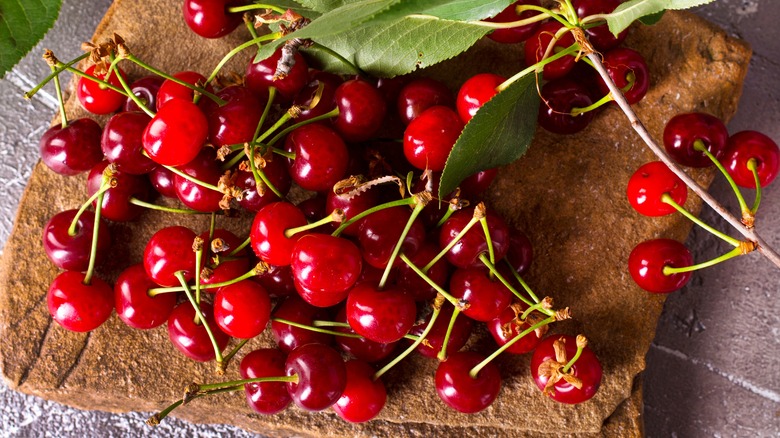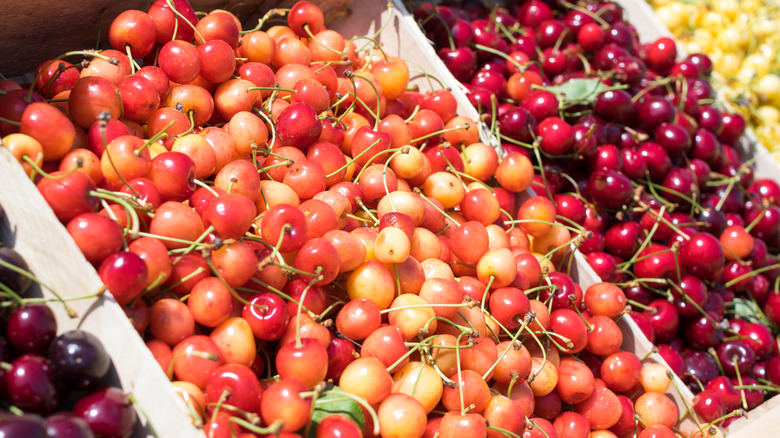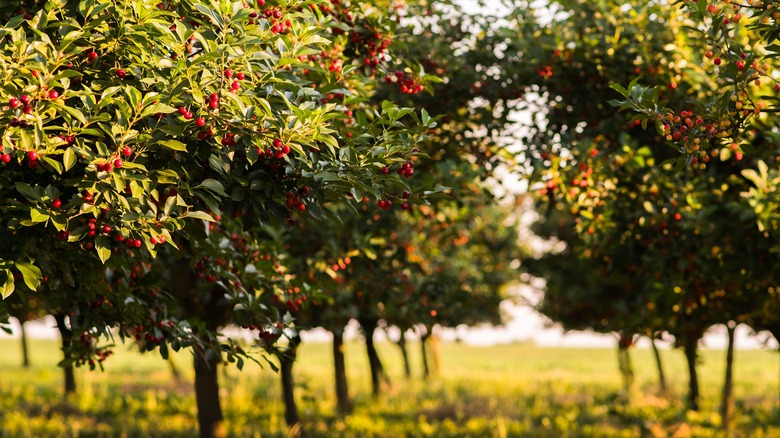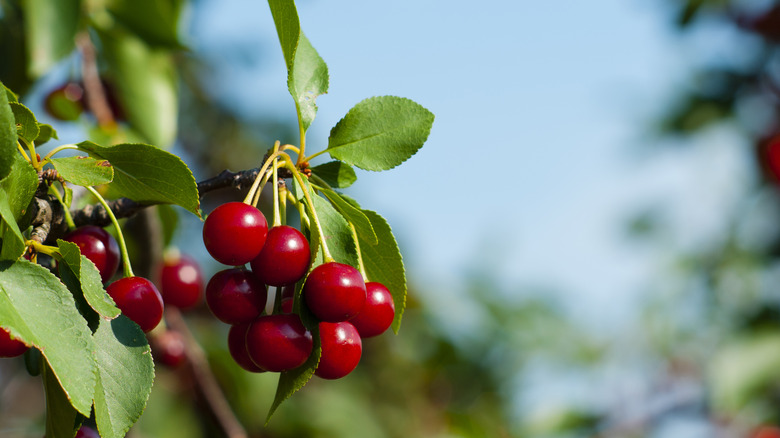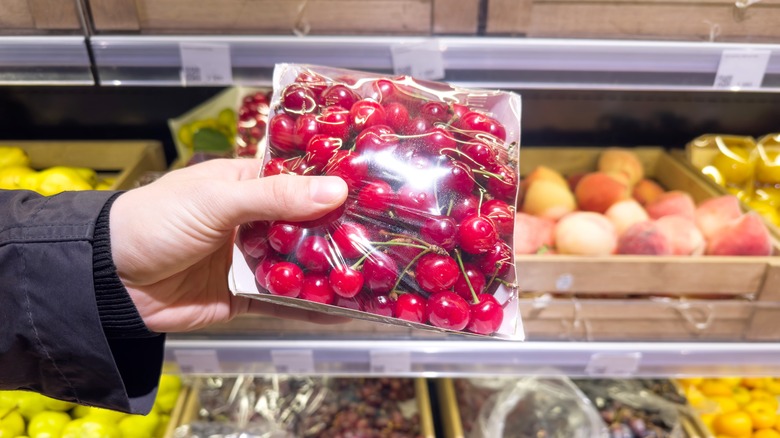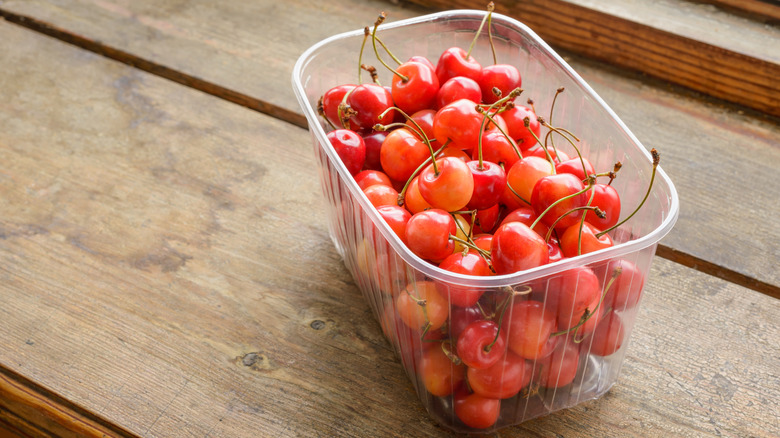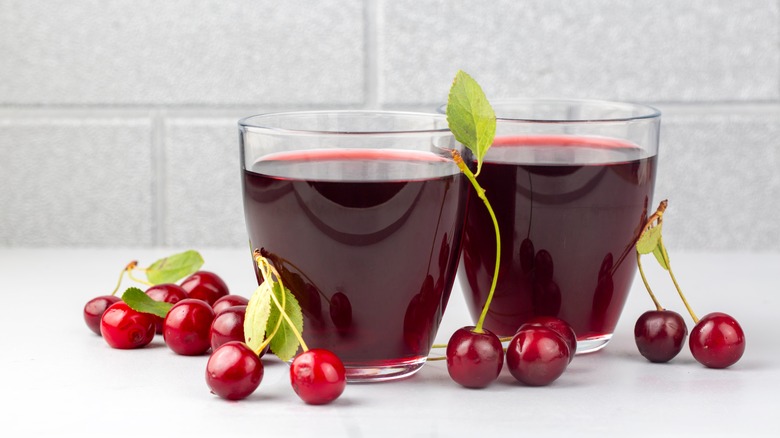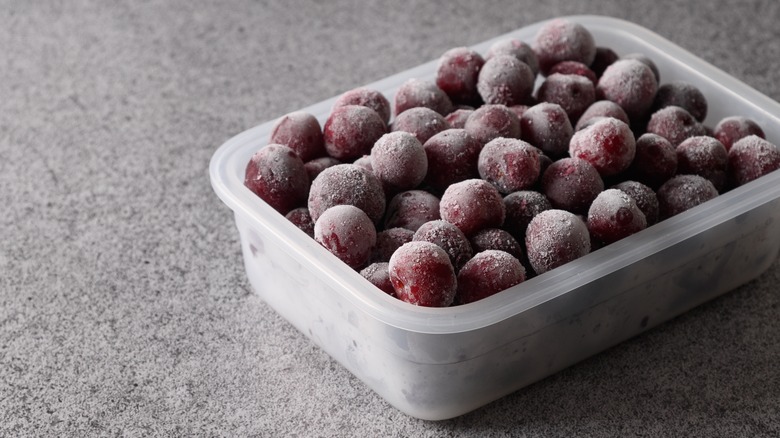Why Sour Cherries Should Become A Pantry Staple
Cherries are a big deal in the United States. Whether they're the star ingredient in various culinary delights like cherry crisps and cherry-filled clafoutis or eaten fresh, the average American eats about 2.6 pounds of them yearly. So, it's no surprise the country is the second largest cherry producer in the world. While there are more than 1,000 varieties of cherries grown in the U.S., most of us have only tried the most popular types of cherries, like Bing or Rainier. These sweet cherries are delicious, but for a truly pucker-producing experience, sour cherries are the way to go.
Having originated in Eastern Europe and Southwestern Asia, sour cherries are believed to have first arrived in the U.S. in the 1600s. Today, the U.S. produces between 275 and 300 million pounds per year. Often overshadowed by their sweeter counterparts, sour cherries should become a staple in your pantry. In culinary school, I learned to balance the flavor of sour cherries in sweet and savory dishes, and as a professional chef, I've used the frozen variety frequently to make the most flavorful bite-sized cherry tarts at events I've catered.
It can be tricky to find sour cherries fresh outside of the region they're grown in. But if you are able to score a bag, these tart gems pack a powerful punch with a unique taste.
What are sour cherries?
Summer is synonymous with the arrival of fresh cherries. But while sweet cherries are typically the center of attention, as previously mentioned, it's the tangy sour cherries that should be on everyone's culinary bucket list. Here's why.
Sour cherries are stone fruits often referred to as tart cherries, because — as their name implies — they boast an extremely tart taste. Unlike sweet cherries, which can be enjoyed fresh, sour cherries are typically too sour to snack on by hand and are instead used in cooking or baking. Unsurprisingly, sour cherries have a higher level of acidity and contain less sugar than sweet cherries, which is what gives them their tart flavor. Cooking them, especially with added sugar, softens their tartness, making them a delicious addition to baked goods (think a sour cherry pie). They also make excellent jams. But in addition to sweeter dishes, they can add a bright burst of flavor to sauces and marinades in savory dishes like pork chops, flap steak, or chicken with a cherry balsamic sauce. You can even make brandied cherries out of this tart fruit for a more unique twist in your favorite cocktails.
Due to their short, weeks-long growing season, finding this delicate and fragile fruit fresh is like finding a four-leaf clover. You're most likely to find sour cherries frozen, canned, dried, or turned into juice.
Sour cherries vs. sweet cherries
There are two main categories of cherries commonly available in the United States: sweet and sour. There are numerous differences between sweet and sour cherries, including color, size, and taste. Sweet cherries are typically larger and juicier, with a rich, sweet taste that makes them perfect for snacking. These are the cherries you'll most likely see piled high in your grocery store's produce section or at the farmer's market in summer. Sweet cherries range in color from deep red to golden yellow, depending on the variety.
Sour cherries are a hybrid fruit, as a natural crossbreed of sweet cherries and the more tart and acidic ground cherries. Besides the stark difference in taste, sour cherries are also smaller, softer, and have a much thinner skin than their sweet counterparts. Color is often the easiest way to tell sweet and sour cherries apart, however. Sour cherries can have flesh that is yellow or red in color, depending on whether they are in the Amarelle or Morello cherry families, respectively.
After working with both sweet and sour cherries, I tend to think of sour cherries as more of an ingredient. They require some level of processing or cooking before they can be used, while sweet cherries are ready to eat as is.
Where are sour cherries grown?
While over two dozen countries grow sour cherries, Russia produces the most. For example, their sour cherry industry produced 297,200 tons of the fruit in 2022 alone, which accounted for more than 18% of sour cherry production worldwide. Poland and Ukraine rounded out the top three. The United States ranked seventh that same year, producing more than 100,000 tons of sour cherries.
America's sour cherry industry is largely centered in the Midwest, with Michigan producing about three-quarters of all sour cherries grown in the U.S. Many of those growers are located in or near Traverse City, which is the self-proclaimed cherry capital of the world. Washington, Oregon, Wisconsin, Pennsylvania, New York, and Utah also contribute to the country's sour cherry supply. Both weather effects from Lake Michigan and the Wolverine State's fertile soil play a huge role in Michigan providing the perfect climate for sour cherry production. As an example, sour cherry trees are tough, so they can withstand the bitter cold Michigan winters.
When are sour cherries in season?
Blink twice and you'll miss sour cherry season — unless you count the weeks and months leading up to it, when cooks and bakers lucky enough to live in an area where they can buy this fruit fresh anticipate their arrival. While there are some sour cherry varieties that ripen earlier or later, the season typically lasts from late June to July, making them a fleeting summer fruit. In some areas, sour cherry season might last only a week.
You can find tart cherries in Pennsylvania in late June. In Utah, sour cherries are usually ready for harvest two weeks after sweet cherries, so you can find them there in mid-July. Meanwhile, sour cherry season in New York can extend into August. If you want to see and taste fresh sour cherries in person, you might consider planning a trip to Northern Michigan in late June or early July for the National Cherry Festival.
If you're craving them in the off-season, grab a bag of dried sour cherries at your grocery store. As a caterer, one of my most-requested hors d'oeuvres for cocktail parties was mushrooms stuffed with sausage and dried tart cherries. This fruit also adds a vibrant burst of flavor to salads.
Where to buy sour cherries
Your best bet for buying sour cherries is to find them frozen, dried, canned, or pureed in syrups in grocery stores. However, their extremely short growing season and even shorter shelf life makes finding them fresh in your local grocery store a rarity, even if you live in or near a growing area. Indeed, while sweet cherries have a shelf life of about two to three weeks when refrigerated, sour cherries will only last three to seven days. Sour cherries are also fragile. Their thin skin (that bakers love) would not hold up well to the long-distance travel required to ship them across the country. These are a few of the reasons why you're more likely to find sour cherries frozen or canned. Most of the sour cherry supply — about 80% — is bought by commercial businesses and processed in these ways for sale to consumers.
Thankfully, there are numerous online sources for purchasing sour cherries. Brecknock Orchards and Harvest Lane Farm Market in Pennsylvania sell frozen tart cherries, costing $28.75 for 5 pounds and $4.50 for 1 pound, respectively. Meanwhile, Zingerman's Mail Order will ship this fruit packed in syrup right to your door for $19 per 13.5-ounce jar.
Varieties of sour cherries
Over 300 varieties of sour cherries exist, but those you're used to seeing likely fall into one of two aforementioned categories: Morello or Amarelle. The primary differences between the two are both the color of the fruit's skin and flesh. Morello cherries are known for their darker skin that's usually deep red to almost black and their dark red flesh. They were once the most coveted cherry in Europe, and they're still more commonly found there today. Morellos are usually sold as preserves or jarred in syrup. They're also often pitted and soaked in brandy for use in cocktails. Meanwhile, Amarelle cherries have a surprisingly clear flesh and bright red skin.
One type of Amarelle cherry stands out as the most common variety: Montmorency cherries. The United States produces more than 94% of all Montmorency cherries, with over two-thirds of them grown by Michigan-based farmers. Balaton cherries, a Morello variety, are another popular sour cherry variety. They are usually bigger and firmer than other sour cherries.
How to cook with sour cherries
Cooking with sour cherries will open your palate to a new world of flavors, and you'll quickly learn that their tartness is a delicious complement to many others. Given their name and the fact that sour cherries are not meant to be eaten fresh, it may be surprising that they're such a popular choice for cooking and baking. However, cooking actually mellows the astringency naturally present in sour cherries. Their tartness is also calmed significantly when added to foods with other flavors — and especially sugar. Bakers love sour cherries because they keep their vibrant color after they're cooked, and they also maintain their shape even when baked into pies.
For a New York City-themed dinner party I once catered, I simmered frozen sour cherries with sugar, freshly squeezed lemon juice, and a dash of vanilla extract to make a decadent, not-too-sweet topping for a New York-style cheesecake. I also used it as a tasty topping for ice cream and waffles. However, I would suggest that you taste the sour cherries as they cook to gauge whether you need to add more sugar. It can be tricky getting the sweet-tart balance right if you're not used to cooking with this fruit.
Beyond sour cherry desserts, there are numerous ways to use this fruit in your kitchen. These cherries are often used to add brightness to sauces. In particular, rich proteins like roast duck and lamb benefit from the flavorful contrast the tartness from sour cherries provides.
Nutritional value of sour cherries
In addition to the flavor they add when they're cooked, sour cherries also offer a number of nutritional and health benefits. They're packed with essential nutrients that can help improve your health and prevent some disease. One cup of pitted, fresh sour cherries contains only about 77½ calories, 2½ grams of fiber, and 1½ gram of protein. They're a good source of vitamin C, which supports better immune function, and vitamin A, which is important for vision. If you want to add more antioxidants into your diet, sour cherries are the fruit for you! They contain flavonoids, a type of antioxidant that not only gives cherries their color, but that can also help to improve heart health and reduce inflammation.
Drinking tart cherry juice regularly can also help reduce cholesterol and lower your blood pressure. If you're battling insomnia, sour cherries contain melatonin, which is a hormone that can help you sleep.
How to store sour cherries
If you're lucky enough to score fresh sour cherries, it's important to store them properly. They are fragile and highly perishable by nature, requiring careful handling or quick use to maximize their shelf life. Freezing or canning this tart fruit are your best options to make them last. You can place the sour cherries — unwashed — in an airtight container in the fridge, but this will only give you about a week to use them. Washing the cherries before you're ready to use them will cause them to deteriorate faster.
So, if you really want to make your sour cherries last, freezing them is a great option. A personal chef client once came back from a summer vacation in Michigan with 6 pounds of sour cherries. We got them ready for the freezer by rinsing them and removing the pits and stems. Next, we laid them out on clean kitchen towels and gently patted them dry. It's imperative that you're careful with sour cherries, as they're softer than sweet cherries and won't hold up to rough handling. Once the sour cherries were dry, we placed them on a baking sheet lined with parchment to freeze. After the cherries were frozen solid, we used a vacuum sealer to package them. Some went into small bags for use in smoothies, while larger bags were filled for use in pies.
You can also place frozen sour cherries in resealable plastic bags or in airtight, freezer-safe containers. Either way, this storage method will ensure that you'll be able to enjoy these tart summer cherries year-round!
